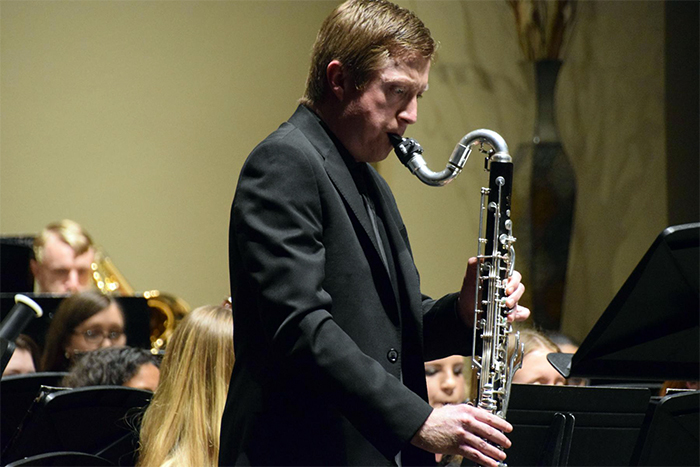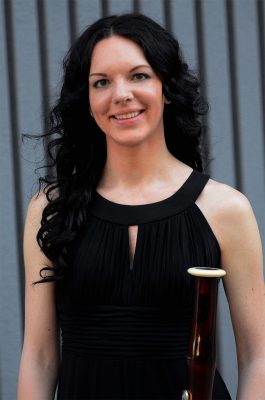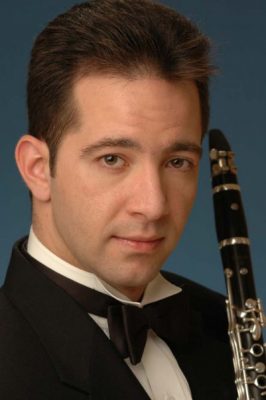
By Lana Sweeten-Shults
GCU News Bureau
Delivering the Mighty Morphin Power Rangers via the might of the bass clarinet?
Just call it a day in the musical life of Grand Canyon University clarinet professor Tim Haas.

Haas doesn’t stick to just the Bachs and the Beethovens when it comes to music, and he prods his students to do the same: “There’s just so much good stuff out there. If you limit yourself to Mozart, you’re missing out on a lot,” he said.
So when it came time to start putting together his first faculty recital of the academic year – it starts at 7:30 p.m. Thursday, Sept. 27, in the GCU Recording Studio -- Haas didn’t want to be the reed swayed by the wind of the tried-but-true composers. He wanted to dive into new music.
“The oldest piece (in the recital) is from 2006, so it’s all new stuff,” Haas said, including “The Blues Ranger,” a jazz clarinet piece by Josh Oxford based on the Mighty Morphin Power Rangers children's television series from the 1990s.
It is one of four pieces Haas will perform at the recital, dubbed “21st Century Bass Clarinet.” The concert will spotlight not only Haas but GCU professor Dr. Kristilyn Woods on bassoon and Mesa Community College clarinet professor Dr. Jeff Quamo on bass clarinet.
“When I was in elementary school, I was a big fan of the television show Mighty Morphin Power Rangers," Oxford writes of the work. "Part of the show’s theme ('Go, go, Power Rangers!') is embedded a few times in the piece and serves as the basis for a lot of the material. The piece prominently features the blues scale and the octatonic scale, often seamlessly moving from one scale to the other.”
A jazz piece called “Lyddimy,” which Haas will perform with Woods, also prominently features another musical scale – the Lydian diminished scale. George Russell’s Lydian Chromatic Concept of Tonal Organization influenced the writing of such jazz greats as Miles Davis and Bill Evans and now, the piece's composer, Glendale Community College professor Dr. Thomas Breadon Jr.
The work “gets really fast at some points and jazzy at some points,” Haas said, and he'll power through the piece with some improvisation as well.

The concert also will feature a composition called “… and the Beast …” by Jonathan Russell, a teaching assistant in the Harvard music department. Haas will duet on the work with fellow bass clarinetist Quamo.
Russell said “ … and the Beast …” began its life as an exercise in tuning perfect fifths that grew and morphed into a depiction of a day in the life of the common beast. Each movement depicts a different action of the Beast – waking up, creeping, dancing (or trying to), attacking and, finally, going to sleep.”
“It’s a five-movement work and a very sinister-sounding work,” said Haas, adding, "The piece showcases the entire range of the bass clarinet. The instrument is known for being able to play low notes, but the bass clarinet can also play really, really high notes, too."
Haas also will delve into “The Flowers of St. Francis” by Daniel Dorff. The composition is inspired by the life of St. Francis of Assisi, the founder of the Franciscan Order.
U.S. Marine Band bass clarinetist Barbara Haney commissioned Dorff to write her a solo piece to premiere at the 2013 ICA ClarinetFest in Assisi, Italy. The work is divided into five sections: “The Flowers, Celebrated by St. Francis,” “St. Francis Preaching to the Birds,” “St. Francis Pacifying the Wolf,” “St. Francis Preaching to the Fish” and “The Starry Skies, Celebrated by St. Francis.”
“He really uses the bass clarinet to show these scenes,” Haas said.
The audience will hear the bass clarinet erupt in bright sounds that emulate birds chirping in “St. Francis Preaching to the Birds." It puts to music the story of St. Francis imploring hundreds of birds: “Oh birds, my brothers and sisters, you have a great obligation to praise your Creator, who clothed you in feathers and gave you wings to fly with, provided you with pure air and cares for you without any worry on your part.” It is said the birds stood still and gazed at him attentively as he walked among them.
They also will hear daunting wolf sounds during “St. Francis Pacifying the Wolf." It is based on the story of St. Francis intervening when the townspeople of Gubbio, Italy, wanted to kill a wolf that had been killing livestock and people. According to the story, St. Francis tamed the wolf, talking it into never killing again. The wolf would become a pet of the townspeople, who made sure he always had plenty to eat.
Two of Haas’ GCU music students who are also digital design students – Julia Gregory and Athena Russell – are creating artwork to be displayed during the performance.
Gregory created two different artworks for the recital: One is inspired by the fourth movement, "St. Francis Preaching to the Fish," when "the bubbles come in," she said, as well as a work that shows St. Francis in the midst of a starry night. Russell will display three digitally painted artworks. The other uses bright colors to represent a field of flowers under bright moonlight, a monochrome birds piece that uses dark and light shades of a reddish-burgundy tone, and then a work that will represent the serene portion of the wolf movement.
"The best part about listening to music and getting inspiration from it is when each part of the music tells a different story -- and being able to bring that story from the ear into a visual perspective," Gregory said.
"What inspired me about the music," said Russell, "is that each movement conveyed a vastly different 'feeling' from the last."
She said "Pacifying the Wolf" influenced her the most: "I had to pay attention to how the half of the piece I was painting differed from the other half. I had to portray the stark difference between the angry wolf from the beginning of the movement and the wolf that became St. Francis' companion later on, so I wanted to make a piece that is somber, yet warm. Hopefully these ideas come through to the audience in the completed paintings."

Haas, who is from San Diego, started playing clarinet when he was in sixth grade – but not without some protest.
His mother suggested that he sign up for band; he repeatedly told her no.
“When I got to the first day of sixth grade, I was in my second period class and the teacher made an announcement: ‘The following people are to go over to the high school, which was right next to the middle school, for band,' and he called my name.”
When the band director asked him to choose an instrument, he picked the clarinet because it looked the most like a recorder, which he played "a little" in fifth grade.
He remembers how mad he was at his mom for signing him up for band, but he doesn't feel that way these days: “I think of that story a lot,” Haas said. “My mother passed away in January, and I know if it wouldn’t have been for her, I wouldn’t be doing what I’m doing today.”
After earning his bachelor’s degree from Arizona State University – his parents’ alma mater – and his master’s degree from Florida State University, Haas decided to take a year off before pursuing his doctorate, so he moved back to Phoenix.
“I came very close to giving up on music,” he said.
He worked a couple of jobs while trying to build a private studio and land some gigs. Then his second year here, post master’s degree, things started to take off.
“I was incredibly fortunate to be in the right place at the right time for a lot of things, including getting the position here at GCU.”
Haas has been an instructor in the music department since 2012. In addition, he performs with the Symphony of the Southwest, the Canyon Symphony Orchestra, the West Valley Symphony and the Four Seasons Orchestra. He also teaches saxophone and clarinet at his private studio.
Haas’ love of the bass clarinet started about a decade ago. He bought a bass clarinet, hoping it would help him in booking performances. Around the same time, he took on a bass clarinet student. He hadn’t done much bass clarinet playing until then and had to do a lot of research on bass clarinet repertoire for his student to play.
“As I found more and started listening to more bass clarinet solos, like the ones I am performing at the recital, I started to see how versatile an instrument it is – it isn’t just for playing the bass line.”
He’s hoping that by performing these new works, “students will hear music they might not ordinarily get exposed to. I want to show my students what’s out there.”
He added, “The more I play the bass clarinet, the more I fall in love with it, and I love showcasing what the instrument can do.”
Contact GCU senior writer Lana Sweeten-Shults at 602-639-7901 or at [email protected].
IF YOU GO
What: "21st Century Bass Clarinet"
When: 7:30 p.m. Thursday, Sept. 27
Where: GCU Recording Studio in the Technology Building (Building 57), fourth floor
Admission: Free
Information: 602-639-8880 or [email protected]
****
Related content:
GCU Today: GCU Recording Studio features room(s) with a view
GCU Today: New home sets stage for more fine arts growth
GCU Today: Recital a high note for GCU's Vladikovic















